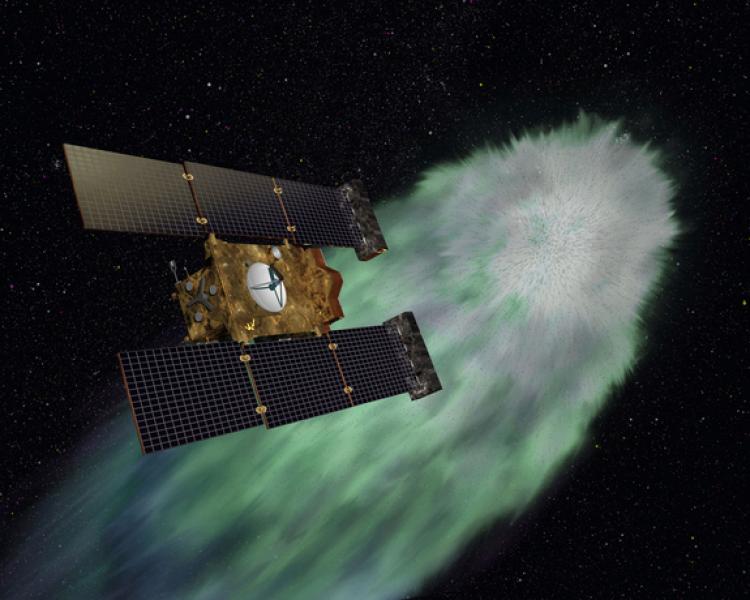Watch the live images from NASA here.
Stardust, the veteran NASA spacecraft, is hurtling towards its Valentine’s Day comet flyby at around 24,000 mph, destination Tempel-1.
The pair ais set to meet at approximately 11:40 p.m. EST (8:40 p.m. PST), with a distance of only 124 miles between the spacecraft and the comet at the time of closest encounter—the New Exploration of Tempel-1 (NExT).
Stardust will initiate a series of milestones during the fateful encounter—the spacecraft will point its protective shields towards the comet— and at about four minutes to closest approach, Stardust will begin to image Tempel-1 and perhaps catch a glance of its nucleus.
“As comets sweep through the inner solar system, they come alive,” said Mike Belton, a Stardust-NExT co-investigator from Belton Space Initiatives in Tucson, Ariz., according to NASA. “They belch gas and dust, and this outgassing can not only change their orbits, it can also change their rotation rate.”
The nominal imaging sequence will only run for around eight minutes as Stardust’s onboard memory can store no more than 72 high-resolution images. Images should start arriving on Earth at around 3 a.m. EST on Feb. 15 (midnight PST), with each one taking about 15 minutes to transmit.
In total, transmission of all images and science data from Stardust will take around 10 hours.
This information will enable scientists to study changes in the comet’s surface since the last visit from Deep Impact in 2005. The comet has completed one full orbit of the sun since Deep Impact blasted its nucleus with a probe.
“You could argue that comet Tempel-1 is the most unique icy dirtball in our solar system,” said Joe Veverka, Stardust-NExT principal investigator from Cornell University, Ithaca, N.Y. “Not only does it have many intriguing physical characteristics that fascinate the scientific community, it also has been analyzed and scrutinized time and again from the ground and space.”
Live coverage of the Tempel-1 encounter will begin at 11:30 p.m. EST (8:30 p.m. PST) Feb. 14 on NASA Television and the agency’s website, with live commentary from mission control at NASA’s Jet Propulsion Laboratory (JPL) in Pasadena, Calif., and video from Lockheed Martin Space System’s mission support area in Denver.
Live footage and a news conference will also be broadcast on one of JPL’s Ustream channels.
Comet fans can join a real-time chat and ask questions of the Stardust NExT team here .
This is Stardust’s final mission, the end of 12 long years in space, after a distant and diverse journey, including hunting the comet Wild 2 in 2004 to collect samples and deliver them back to Earth in 2006.
The pair ais set to meet at approximately 11:40 p.m. EST (8:40 p.m. PST), with a distance of only 124 miles between the spacecraft and the comet at the time of closest encounter—the New Exploration of Tempel-1 (NExT).
Stardust will initiate a series of milestones during the fateful encounter—the spacecraft will point its protective shields towards the comet— and at about four minutes to closest approach, Stardust will begin to image Tempel-1 and perhaps catch a glance of its nucleus.
“As comets sweep through the inner solar system, they come alive,” said Mike Belton, a Stardust-NExT co-investigator from Belton Space Initiatives in Tucson, Ariz., according to NASA. “They belch gas and dust, and this outgassing can not only change their orbits, it can also change their rotation rate.”
The nominal imaging sequence will only run for around eight minutes as Stardust’s onboard memory can store no more than 72 high-resolution images. Images should start arriving on Earth at around 3 a.m. EST on Feb. 15 (midnight PST), with each one taking about 15 minutes to transmit.
In total, transmission of all images and science data from Stardust will take around 10 hours.
This information will enable scientists to study changes in the comet’s surface since the last visit from Deep Impact in 2005. The comet has completed one full orbit of the sun since Deep Impact blasted its nucleus with a probe.
“You could argue that comet Tempel-1 is the most unique icy dirtball in our solar system,” said Joe Veverka, Stardust-NExT principal investigator from Cornell University, Ithaca, N.Y. “Not only does it have many intriguing physical characteristics that fascinate the scientific community, it also has been analyzed and scrutinized time and again from the ground and space.”
Live coverage of the Tempel-1 encounter will begin at 11:30 p.m. EST (8:30 p.m. PST) Feb. 14 on NASA Television and the agency’s website, with live commentary from mission control at NASA’s Jet Propulsion Laboratory (JPL) in Pasadena, Calif., and video from Lockheed Martin Space System’s mission support area in Denver.
Live footage and a news conference will also be broadcast on one of JPL’s Ustream channels.
Comet fans can join a real-time chat and ask questions of the Stardust NExT team here .
This is Stardust’s final mission, the end of 12 long years in space, after a distant and diverse journey, including hunting the comet Wild 2 in 2004 to collect samples and deliver them back to Earth in 2006.






